A program Science as an Art: The Amusing World of Jean Painlevé
 French director Jean Painlevé (1902–1989) made more than two hundred science films in his life, most of them about marine animals. When he was young he was interested in avant-garde art, and his works were always trained in two directions at once: toward “knowledge” and toward “beauty.” Combining a serious spirit of inquiry with a sense of fun, the charm of his works remains unfaded even today. This program is an introduction to eight major works of this world leader of the science-film community, including his representative work, about the animal that became a symbol of this “man of science films,” The Sea Horse.
French director Jean Painlevé (1902–1989) made more than two hundred science films in his life, most of them about marine animals. When he was young he was interested in avant-garde art, and his works were always trained in two directions at once: toward “knowledge” and toward “beauty.” Combining a serious spirit of inquiry with a sense of fun, the charm of his works remains unfaded even today. This program is an introduction to eight major works of this world leader of the science-film community, including his representative work, about the animal that became a symbol of this “man of science films,” The Sea Horse.
—Okada Hidenori
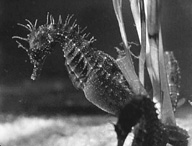 The Sea Horse
The Sea Horse
L’Hippocampe ou “cheval marin”- FRANCE / 1934 / French / B&W / DVD (Original: 35mm) / 13 min
Director: Jean Painlevé
Photography: André Raymond
Music: Darius Milhaud
Commentary: Ben Danou
Source: Les Documents Cinématographiques
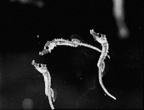 Taking a close look at the ecology of the sea horse, this is a monumental work of Painlevé’s that made the fish itself a symbol of his science-film work. He focused his attention on things like the mechanism by which the sea horse swims vertically, and the unique behavior wherein the male carries eggs laid by the female. You may notice that the composition is influenced by avant-garde film.
Taking a close look at the ecology of the sea horse, this is a monumental work of Painlevé’s that made the fish itself a symbol of his science-film work. He focused his attention on things like the mechanism by which the sea horse swims vertically, and the unique behavior wherein the male carries eggs laid by the female. You may notice that the composition is influenced by avant-garde film.
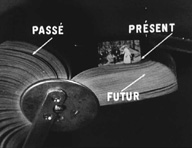 The Fourth Dimension
The Fourth Dimension
La quatrième dimension- FRANCE / 1937 / French / B&W / DVD (Original: 35mm) / 10 min
Director: Achilles Pierre Dufour
Producer: Jean Painlevé
Source: Les Documents Cinématographiques
Painlevé, who himself established a science-film association and became its president, produced films in the 1930s for an expo on mathematics and astronomy. Directed by Achilles Pierre Dufour, a special-effects technician, this is an ambitious work which attempts to express through film the concept of the fourth dimension using line animation.
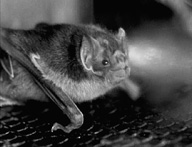 The Vampire
The Vampire
Le vampire- FRANCE / 1939-45 / French / B&W / DVD (Original: 35mm) / 9 min
Director: Jean Painlevé
Photography: André Raymond
Music: Duke Ellington
Source: Les Documents Cinématographiques
Made at the request of L’Institut Pasteur, this is a work which probes the ecology of South American bats that attack cows and horses. It captures, with deft editing, the bats in action, even showing them sucking the blood of small animals. Before the bat appears, there is a thought-provoking clip of F.W. Murnau’s masterpiece, Nosferatu (1922), showing another example of a blood-sucking creature.
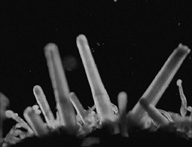 Sea Urchins
Sea Urchins
Oursins- FRANCE / 1954 / French / Color / DVD (Original: 35mm) / 11 min
Director: Jean Painlevé
Assistant Director: Geneviève Hamon
Photography: Claude Beausoleil
Source: Les Documents Cinématographiques
This is Painlevé’s first color picture, a remake of his own film of the same title produced during the silent era. The film not only elucidates the complex mechanism of the spines and stems of the sea urchin, it also gives the impression of abstract cinema in its adventurous magnified filming of the spines and stems. Furthermore, the film has its whimsical touches, featuring, for example, sea urchins lined up on the beach to spell out the titles and credits.
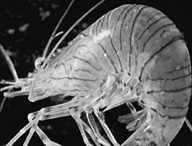 Shrimp Stories
Shrimp Stories
Histoires de crevettes- FRANCE / 1964 / French / Color / DVD (Original: 35mm) / 10 min
Directors: Jean Painlevé, Geneviève Hamon
Music: Pierre Conté
Source: Les Documents Cinématographiques
Beginning with the fun beach activity of fishing for shrimp, this movie goes on to carefully explain things like the function of the shrimp’s claws, its system of predation, reproduction, and infant metamorphosis. From this period onward, Geneviève Hamon (Ginette, Painlevé’s lifelong companion), is credited as co-director.
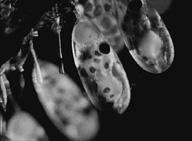 The Love Life of the Octopus
The Love Life of the Octopus
Les amours de la pieuvre- FRANCE / 1965 / French / Color / DVD (Original: 35mm) / 13 min
Directors: Jean Painlevé, Geneviève Hamon
Music: Pierre Henry
Source: Les Documents Cinématographiques
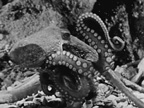 A film in which the progress of two octopuses is patiently observed as they grow close to each other, mate over an extended period, and in due course lay and hatch eggs. The sight at the start of the film of an octopus destroying and eating a hard-shelled crab is impressive. The electric sounds of “musique concrète” are effectively used.
A film in which the progress of two octopuses is patiently observed as they grow close to each other, mate over an extended period, and in due course lay and hatch eggs. The sight at the start of the film of an octopus destroying and eating a hard-shelled crab is impressive. The electric sounds of “musique concrète” are effectively used.
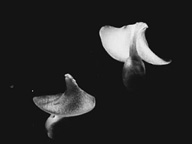 Acera, or the Witches’ Dance
Acera, or the Witches’ Dance
Acéra ou le bal des sorcières- FRANCE / 1972 / French / Color / DVD (Original: 35mm) / 13 min
Directors: Jean Painlevé, Geneviève Hamon
Music: Pierre Jansen
Source: Les Documents Cinématographiques
The acera is a kind of hermaphroditic mollusk. The film elegantly captures the sight of a number of aceras swimming, flitting their cape-like organs to the dramatic melodies of the great composer Pierre Jansen. Watch also for the brief intercut image of a person dancing.
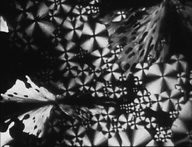 Liquid Crystals
Liquid Crystals
Cristaux liquides- FRANCE / 1978 / French / Color / DVD (Original: 16mm) / 6 min
Director: Jean Painlevé
Photography: Yves Bouligand
Music: François de Roubaix
Source: Les Documents Cinématographiques
A micrographic film that draws the viewer up close to the beauty of liquid crystal, a substance that alters its composition, form, and color in response to changes in temperature and pressure. Painlevé still aimed at a fusion of science and the avant-garde even in his later life. The music used is by François de Roubaix, known for his impressive Les Aventuriers (1967) score, and, like Painlevé himself, as a lover of diving.
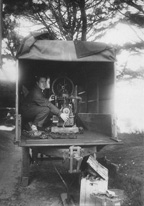 Jean Painlevé Jean Painlevé
Born in 1902, the son of mathematician Paul Painlevé, from a young age he spent all his time in movie theaters. At a summer resort in Bretagne, he was fond of playing with sea creatures. His father, who was in politics, ascended to the seat of Prime Minister in 1917, just prior to the end of World War I. Although in 1921 Jean had decided to study medicine at the Sorbonne, he changed to biology midway through, and there he met Geneviève Hamon in the marine-plants laboratory. Nicknamed Ginette, she was to be his partner for life, both romantically and professionally. Back in Paris, he deepened his interactions with young stars of surrealism like the Prevert brothers and Pierre Naville. The words of Ivan Goll, a poet in this group, “Everything an artist creates is born in nature,” became the underlying tenet of Painlevé’s creed. The currents of French avant-garde cinema—Fernand Léger’s Ballet mecanique (1924), Rene Clair’s Entr’acte (1924), Luis Buñuel’s Un chien andalou (1929), and so on—pointed Painlevé down two paths simultaneously: that of science, and that of film. Director Jean Vigo, who had become his friend, shared his belief that cinema would play a major role in transforming society. In 1934, Painlevé established his renown as a science-film director with The Sea Horse. This film inspired artists and thinkers like Marc Chagall and Georges Bataille, while the funny-looking fish became a symbol of Painlevé’s work. During World War II, while Painlevé continued to affirm the connections between the worlds of science and movies, he was also active in the French Resistance and involved with other left-wing filmmakers in the establishment of the Comité de Libération du Cinéma Français (CLCF). In 1944, as soon as Paris was liberated from the German Army, Painlevé was put in charge of film by the CLCF, and for the initial nine-month period of post-war recovery, he was involved in many efforts to rebuild the film world, for example as a member of the Commission Supérieure Technique du Cinéma Français and in his successful founding of a department for newsreels.
Painlevé’s films can be divided into three categories, according to their different kinds of assumed viewers: “academic films,” aimed at scientists; “educational films,” intended for use in places like universities; and “shorts for general viewing.” Until his passing in 1989, Painlevé used a diverse network of people to make films of universal interest, leaving a life's work of more than 200 films that constantly reinvented the genre of science films. —Okada Hidenori |

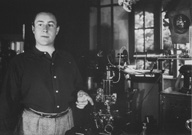 After the war, Painlevé not only launched into organizing the science-film community, he also revived the science-film association he himself had created in the 1930s, making Georges Franju (later a director himself) office head. In 1946, he held an international science-film festival. The following year, he founded the Association Internationale du Cinéma Scientifique (AICS) and became its director. Recommencing his own filmmaking as well, in 1948 he broadcast a science television program; in 1954, he remade his 1929 film Sea Urchins under the same title but this time in color, and was back making films as before.
After the war, Painlevé not only launched into organizing the science-film community, he also revived the science-film association he himself had created in the 1930s, making Georges Franju (later a director himself) office head. In 1946, he held an international science-film festival. The following year, he founded the Association Internationale du Cinéma Scientifique (AICS) and became its director. Recommencing his own filmmaking as well, in 1948 he broadcast a science television program; in 1954, he remade his 1929 film Sea Urchins under the same title but this time in color, and was back making films as before.